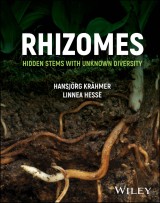Details
Rhizomes
Hidden Stems with Unknown Diversity1. Aufl.
|
152,99 € |
|
| Verlag: | Wiley |
| Format: | |
| Veröffentl.: | 26.06.2024 |
| ISBN/EAN: | 9781119827153 |
| Sprache: | englisch |
| Anzahl Seiten: | 416 |
DRM-geschütztes eBook, Sie benötigen z.B. Adobe Digital Editions und eine Adobe ID zum Lesen.
Beschreibungen
<p><b>Comprehensive reference on the characteristics of rhizomes, stems growing roughly horizontally below ground level, important for perennial and hard-to-control weeds and for the propagation of some commercially important crops. </b> <p><i>Rhizomes</i> describes and compares rhizomes, classifies them based on their features, and presents their ecological and commercial importance. <p>The book is divided into seven parts. After a short introduction, Part I discusses the evolution of rhizomes and their function as organs. Part II provides an introduction into rhizomes of basal tracheophytes, formerly called pteridophytes, now referred to as Lycopodiopsida and Polypodiopsida or lycophytes and ferns. Part III covers monocot rhizomes with a focus on the high diversity of rhizomes found in monocots. Part IV focuses on dicot rhizomes and their morphological diversity. Part V explores the ecological and commercial importance of rhizomes, with special information on crops and weeds with rhizomes. Lastly, findings on rhizomes in different plant groups are compared, and conclusions on the development and diversification of rhizome characters are presented. <p>Written by two highly qualified authors with significant research experience in the field, <i>Rhizomes </i>covers topics such as: <ul><li>Difficulty in making a clear distinction between rhizomes, runners, and stolons and inner cortex cells of rhizomes differing in sheath modifications </li><li>Different types of species with stem-borne roots, including dicot representatives with roots arising from the hypocotyl and plants with roots at nodes, internodes, and buds </li><li>Molecular genetics research analyzing molecular mechanisms and signaling processes leading to stolon and rhizome initiation and development </li><li>Rhizome producing species forming either large colonies or genetically identical groups, with advantages and disadvantages of each </li></ul> <p>With English literature on rhizomes being relatively sparse, <i>Rhizomes </i>is a unique and highly comprehensive reference on these types of stems, ideal for agronomists, botanists, horticulturists, breeders, ecologists, and weed scientists seeking to understand their important role in agriculture and food.
<p><b>Hansjörg Krähmer,</b> Past President of the European Weed Research Society and currently based at Bayer AG, Frankfurt, Germany. Dr. Krähmer is a known scientist studying weed plants, crop science, and vegetative anatomy and morphology. <p><b>Linnea Hesse,</b> Professor, Wood Sciences and Biomimetics, Institute of Wood Science, University of Hamburg, Germany.
<p><b>Comprehensive reference on the characteristics of rhizomes, stems growing roughly horizontally below ground level, important for perennial and hard-to-control weeds and for the propagation of some commercially important crops. </b> <p><i>Rhizomes</i> describes and compares rhizomes, classifies them based on their features, and presents their ecological and commercial importance. <p>The book is divided into seven parts. After a short introduction, Part I discusses the evolution of rhizomes and their function as organs. Part II provides an introduction into rhizomes of basal tracheophytes, formerly called pteridophytes, now referred to as Lycopodiopsida and Polypodiopsida or lycophytes and ferns. Part III covers monocot rhizomes with a focus on the high diversity of rhizomes found in monocots. Part IV focuses on dicot rhizomes and their morphological diversity. Part V explores the ecological and commercial importance of rhizomes, with special information on crops and weeds with rhizomes. Lastly, findings on rhizomes in different plant groups are compared, and conclusions on the development and diversification of rhizome characters are presented. <p>Written by two highly qualified authors with significant research experience in the field, <i>Rhizomes </i>covers topics such as: <ul><li>Difficulty in making a clear distinction between rhizomes, runners, and stolons and inner cortex cells of rhizomes differing in sheath modifications </li><li>Different types of species with stem-borne roots, including dicot representatives with roots arising from the hypocotyl and plants with roots at nodes, internodes, and buds </li><li>Molecular genetics research analyzing molecular mechanisms and signaling processes leading to stolon and rhizome initiation and development </li><li>Rhizome producing species forming either large colonies or genetically identical groups, with advantages and disadvantages of each </li></ul> <p>With English literature on rhizomes being relatively sparse, <i>Rhizomes </i>is a unique and highly comprehensive reference on these types of stems, ideal for agronomists, botanists, horticulturists, breeders, ecologists, and weed scientists seeking to understand their important role in agriculture and food.


















